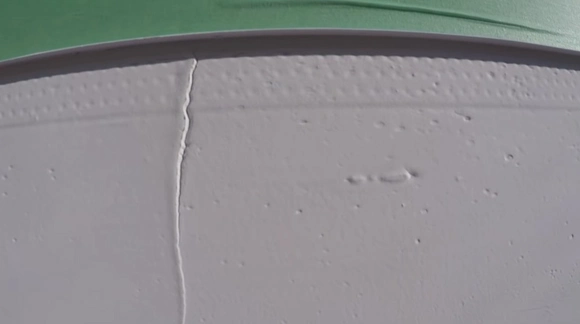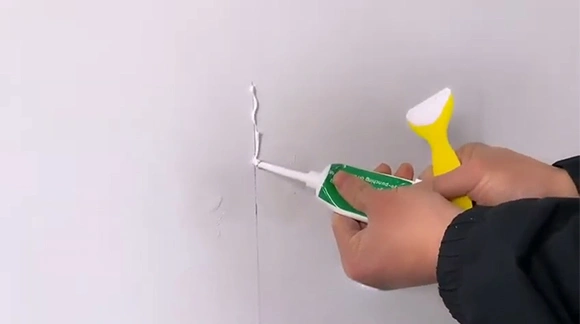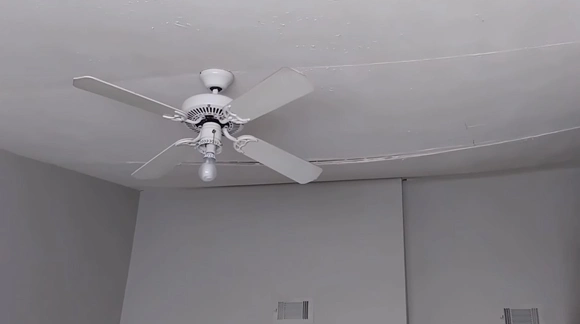Last Updated on March 29, 2023
Cracks in walls can look unsightly, but they could also be a warning sign for your home’s stability. Drywall cracking is becoming increasingly common across the country. And if you’re wondering why it’s happening to yours, there are a variety of potential causes that definitely shouldn’t go ignored.
Drywall cracks can be a silent enemy, seemingly coming out of nowhere. Whether courtesy of foundation settling, temperature fluctuations or even those earthquakes we’ve all been feeling lately, they can cause some serious damage down the line. Better take care and make sure your walls remain steady.
If external forces become too powerful, even the toughest organic materials used in drywall won’t stand up to it. This can cause an apparent unfixable crack. Identifying the cause of these cracks is crucial to prevent them from recurring.
Let’s see what you can do to prevent these cracks from forming in your home.
What Causes Drywall to Crack: Most Common Sources

Many factors can lead to drywall cracking, but the following are the most common:
Poor Installation
Drywall cracking due to poor installation is one of the most common sources. Poor installation can include improper cutting, wrong placement of fasteners, and not using the right type of screws.
Improperly cut drywall panels can cause them to be too big or too small for the space they are filling, leading to stress on the walls when placed and resulting in cracks. Fasteners installed too close or too far apart will cause the drywall to crack due to pressure build-up when nails shift due to temperature changes.
When installing drywall screws, a contractor must ensure they are long enough and driven into studs properly to prevent pull-out from occurring.
Uneven Foundation
Another common source for drywall cracking is an uneven foundation. This can happen when the concrete subfloor isn’t level, or there is excessive settling in certain areas of a structure over time.
The unevenness causes stress points which will eventually result in cracks showing up in the drywall surface. Other signs that an uneven foundation may be causing problems include cracking tiles, creaking noises when walking around the house, and significant gaps between baseboards and flooring materials.

Changes in Temperature
Temperature fluctuations can also cause the drywall to crack. When temperatures drop, metal components inside walls expand as they cool down, creating tension along wall joints and causing them to buckle or crack apart under pressure.
And if a home has poor insulation, warm air seeping through walls during cold months may cause humidity levels inside living spaces to rise beyond what’s considered safe levels for wood materials.
It may lead to the warping or splitting of wooden frames within walls, which will eventually lead to the cracking of drywall material as well as other surface repairs needed for it to look like new again.
Relative Humidity’s Impact
The relative humidity inside a home is another factor that can affect how well drywall holds up over time. If humidity levels get too high, then wetness starts collecting behind walls. This can lead to mold growth and structural issues, such as buckling or splitting wooden frames within walls.
It leads again to unsightly cracks appearing on surface layers of wall coverings such as paint or wallpaper etc. And if humidity levels constantly stay low over extended periods, this can also cause weakened adhesion strength between layers of wall material, making it more prone to cracking under pressure from everyday activities like slamming doors, etc.
Effects of Moisture
Moisture is one of the main culprits behind drywall cracking apart over time. High moisture levels behind your wall surfaces could mean water seeps through from outside, either via roof leaks or plumbing issues. And it should be addressed straight away before more extensive damages occur (e.g., rotting plywood frame boards).
And having wet spots around window sills could point towards condensation forming because windows were not appropriately sealed with weatherproof caulk. This needs to be checked out ASAP before any further problems arise.
Aging Drywall
Lastly, old age itself tends to be one major factor causing drywall surfaces to start showing cracks and other signs of wear & tear. Depending on how much time has passed, different types of fillers used between wall panels tend to become brittle.
The result is a gradual deterioration of the overall strength of the parts until, eventually, some parts collapse due to underweight pressures or vibrations. In some cases, it can be caused by external factors, such as nearby children playing.
Aside from that, although it’s very rare, it’s sometimes due to naturally occurring chemical reactions (e.g., alkali-silica reactions) occurring in different construction materials. It may also weaken adhesive bonds between layers, making them more susceptible to breaking easily. Always be on the lookout for this.
Is It Normal for Drywall to Crack?

Yes, it is normal for drywall to crack, particularly in new or older homes. This is often the result of normal house “settling,” which happens as a home adjusts to its environment and foundation movements due to external factors such as temperature changes and moisture levels.
Settling cracks are common in drywall materials and typically appear as vertical lines that start near the apex and run downward. Fortunately, these drywall cracks are usually minor and do not require any corrective action.
How Do You Know If a Crack in the Drywall Is Serious?
It can be difficult to distinguish between a minor settling crack from a more serious issue with your walls without looking closely at the shape and direction of the crack.
Vertical cracks that start near the apex are less serious than horizontal or jagged 45-degree angle cracks, which might indicate a more severe problem, such as foundation shifting or water penetration.
The severity of these issues can be determined by taking further measurements, such as detecting any moisture levels behind your walls or checking if your windows and doors shut properly.
How Do You Stop Drywall from Cracking?

The best way to prevent cracks in your drywall is through proper installation techniques, such as using screws instead of nails, spacing them properly according to manufacturer specifications, taping off seams correctly, and applying joint compound evenly where needed.
In addition to these practices, you should sign off on cracking first. If any evidence of cracking appears during installation or after completion, then address it immediately rather than waiting until later on, when it may become worse over time due to environmental elements like temperature fluctuations.
Also, keep an eye out for signs of settling after installation by inspecting your walls regularly for any changes in their appearance from time to time so that you can identify potential problems quickly before they become too serious.
Why Is My Drywall Cracking Keep Coming Back?
One of the primary causes is normal settling or seasonal temperature changes, which can cause the drywall to expand and contract over time, creating stress on the joints and resulting in visible cracking.
Poor installation, inadequate support, and inadequate bracing of the drywall can also lead to recurring drywall cracks. And if there is a failing beam or moisture issue in the ceiling, it may be causing the recurring crack due to the additional strain on that area.
Lastly, did you know that structural issues in your home can lead to cracks appearing on drywall and other surfaces? If it looks like this is the case, don’t wait, get a pro involved who’ll be able to identify those pesky underlying problems and make sure they’re fixed for good.
Here are some drywall cracking solutions you can try:
Original Drywall Repair Putty

This product is an all-in-one solution for a variety of drywall repair needs. It can fill cracks, holes, and other imperfections on walls and ceilings made of gypsum boards. The putty’s creamy consistency makes it easy to spread over the damaged area, ensuring a smooth, uniform finish.
It has excellent adhesion properties that make it ideal for interior and exterior applications. And it has a quick drying time of only 10 minutes and, once cured, can be sanded or drilled without compromising its integrity.
Wall Surface Hole Filler
This product is designed for filling large holes in walls made from either plaster or gypsum boards. It is highly flexible, which allows it to expand and contract with the surface, preventing cracks from occurring between repairs.
The filler also contains anti-mold agents which protect against mold growth in humid environments like bathrooms or basements. Furthermore, it can easily be painted over after application and is sandable for fine adjustment to ensure a neat finish.
Heavy Duty Wall Repair Spackling
This product is perfect for tackling larger repairs, such as water or structural cracks on drywall surfaces. Its thick paste consistency allows it to bridge gaps, ensuring a strong bond between the old and new materials while providing maximum stability to the wall surface after curing.
Spackling also dries quickly, allowing multiple coats to be applied if necessary without waiting too long between each layer application. Furthermore, this product is resistant to cracking and offers superior adhesion due to its strong bonding properties when cured fully, making it ideal for more challenging repairs that require extra strength and durability.
When Should I Be Concerned About Drywall Cracks?

Generally, minor hairline cracks or small fissures under five millimeters in diameter don’t need immediate attention. These cracks can often be filled with the best joint compound and painted over to make them barely noticeable.
If you notice a pattern or any larger drywall cracks that measure wider than five millimeters, it may be worth taking a closer look. In all cases where there is an active crack in the wall, further investigation is needed.
Larger cracks may indicate structural issues, such as the settling of the foundation or problems with the framing structure caused by moisture or extreme temperatures. It is important to determine the root cause of these more serious cracks and address them directly before repainting.
Protect Your Home from Costly Repairs Due to Drywall Cracking
Now it is clear that numerous forces of nature can cause stress and pressure on drywall materials resulting in cracking. Paying attention to your home’s foundation and ensuring that it is properly maintained can help reduce the chance of cracks appearing due to foundation settlement or heave.
It is essential to determine the underlying causes of this issue to prevent it from recurring. You can protect your homes from costly repairs caused by drywall cracking by following the above guide and techniques. This knowledge can help you prevent or minimize damage to your home’s structure caused by these forces of nature.



